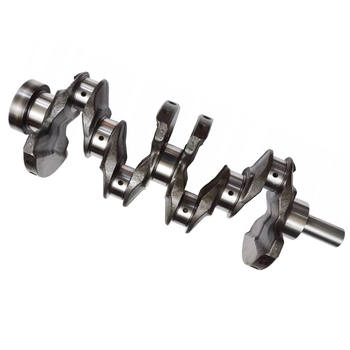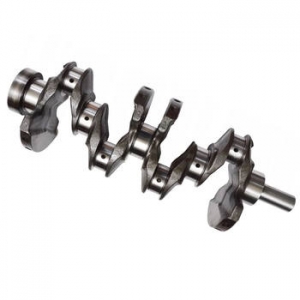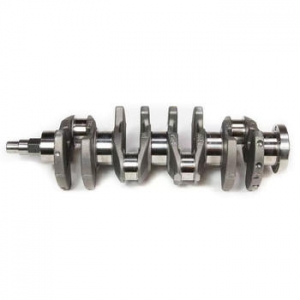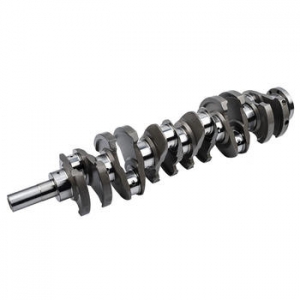The Heart of Horsepower: How to Choose the Right Crankshaft Company
Let's be honest, when you're building or rebuilding an engine, the spotlight often shines on the big, flashy components—turbochargers, cylinder heads, or that aggressive camshaft. But deep within the engine block lies its true backbone, the component responsible for converting violent combustion events into smooth, usable rotational force: the crankshaft. The quality of this part is non-negotiable. Choosing the wrong one can lead to catastrophic failure, while the right one can be the foundation for reliable, staggering horsepower. This is precisely why selecting a premier Crankshaft company is one of the most critical decisions an engine builder can make.
But how do you navigate this highly specialized market? With so many options, materials, and manufacturing processes, it's easy to feel overwhelmed. Have you ever wondered what truly separates a standard, off-the-shelf crankshaft from a meticulously engineered piece designed for a 1,000-horsepower race engine? It's more than just the price tag. It’s about the engineering, the materials, the quality control, and the philosophy of the company behind it. In this guide, we'll pull back the curtain and explore everything you need to know to make an informed decision and partner with a company that understands the heart of horsepower.
What Truly Defines a Premier Crankshaft Company?
Frankly speaking, any company can machine a piece of metal into the shape of a crankshaft. What sets an elite manufacturer apart is an obsessive commitment to precision and performance that permeates every stage of their operation, from raw material selection to the final balancing and polishing. It's a blend of old-world craftsmanship and cutting-edge technology.
Beyond the Basics: Materials and Manufacturing
The foundation of any great crankshaft is the material it's made from. A top-tier company won't just offer one option; they will have expertise across a spectrum of materials and processes to match the application.
- Cast Iron/Nodular Iron: This is the standard for most factory-production engines. It's cost-effective to produce and perfectly adequate for stock or mildly modified street applications. The process involves pouring molten iron into a mold. While strong, its granular structure makes it more brittle under extreme stress compared to forged or billet options.
- Forged Steel: This is the go-to for most high-performance and racing applications. The process involves taking a heated steel billet and using immense pressure to forge it into the basic shape of a crankshaft. This process aligns the grain structure of the steel, making it incredibly strong and resilient to torsional and bending forces. Common materials include 4340 and 5140 steel alloys, known for their excellent strength and durability.
- Billet Steel: This represents the pinnacle of crankshaft strength and customization. Instead of being forged, a billet crankshaft is machined from a solid, round bar (a "billet") of high-grade steel, often 4340 or even more exotic alloys like 300M. Because it's carved from a solid piece, there are no internal stresses from a forging process, and the design possibilities are nearly limitless. This is the choice for all-out racing, massive power adders, or unique custom-stroke applications.
In my experience, a company's willingness to discuss the pros and cons of each material for your specific build is a huge green flag. They should be a resource, not just a parts seller.
The Role of Engineering and Design
A truly great crankshaft is a work of engineering art. Leading companies invest heavily in their engineering departments, using sophisticated tools like Computer-Aided Design (CAD) and Finite Element Analysis (FEA). FEA software allows engineers to digitally simulate the immense stresses a crankshaft will endure inside an engine, identifying potential weak points and optimizing the design for strength and weight *before* a single piece of metal is ever cut. This leads to innovations like profiled counterweights for reduced windage, lightened rod journals for lower rotating mass, and optimized oiling passages for superior bearing life.
Quality Control: The Non-Negotiable
Consistency is key. A reputable company will have a multi-stage quality control process that is ruthlessly enforced. This includes:
- Magnafluxing: A non-destructive testing method to check for invisible surface cracks in the raw forging or billet and the finished part.
- Dimensional Verification: Using precision instruments like coordinate measuring machines (CMMs) to ensure every journal is perfectly round, every stroke is exact, and every dimension is within incredibly tight tolerances (often measured in ten-thousandths of an inch).
- Precision Balancing: Ensuring the crankshaft is perfectly balanced to eliminate engine-killing vibrations at high RPM. Top-tier companies balance their cranks to much finer tolerances than typical OEM standards.

Forged vs. Billet vs. Cast: Which Crankshaft is Right for Your Build?
This is one of the most common questions engine builders face, and the answer depends entirely on your goals and budget. Understanding the core differences is crucial, and it's a key part of the billet vs forged crankshafts debate.
The Workhorse: Cast Crankshafts
As mentioned, cast cranks are the bread and butter of the automotive world. They are perfectly suitable for daily drivers and engines making modest power increases (typically up to around 450-500 horsepower in a V8, though this varies). They are affordable and readily available. However, if you plan on using significant boost, a large shot of nitrous, or consistently revving to high RPMs, you're venturing into territory where a cast crank becomes a significant liability.
The Gold Standard: Forged Crankshafts
For the serious enthusiast, a forged 4340 steel crankshaft is often the sweet spot. The forging process creates a part that is significantly stronger and more durable than a cast piece, capable of handling the immense cylinder pressures of a high-compression, boosted, or nitrous-fed engine. They offer a massive leap in reliability for a moderate increase in cost over cast. For most street/strip builds, hot rods, and many forms of circle track and road racing, a quality forged crankshaft is the ideal choice. Many experts agree that for builds up to 1,200-1,500 horsepower, a well-designed forged crank is more than sufficient.
The Ultimate Performer: Billet Crankshafts
When you need the absolute strongest part available or require a truly unique configuration, billet is the answer. Machining from a solid bar of premium steel allows for complete design freedom. Need a non-standard stroke length for a stroker kit? A unique journal size? A special counterweight profile for an odd-fire engine? Billet makes it possible. The material itself is incredibly pure and free of potential inclusions, giving it the highest tensile strength. This is the domain of Pro Mod drag racing, tractor pulling, offshore powerboats, and any application where engine failure is simply not an option and the budget allows for the best.

Navigating the World of Custom Crankshaft Design
Sometimes, an off-the-shelf part just won't do. This is where a company's expertise in custom crankshaft design becomes paramount. It's a collaborative process that transforms your specific needs into a functional, reliable component.
When is a Custom Crankshaft Necessary?
You might need a custom crankshaft in several scenarios. The most common is creating a "stroker" engine, where you increase the stroke (the distance the piston travels) to gain more displacement and torque. Other reasons include restoring a rare vintage engine where parts are unavailable, building a high-RPM screamer that requires ultra-lightweight components, or adapting a crankshaft for use in a completely different engine block for a unique swap.
The Custom Design Process: A Partnership
It's worth noting that this isn't a simple transaction; it's a partnership. The process typically begins with a detailed consultation with one of the company's engineers. You'll need to provide critical information, including:
- Engine block type
- Desired stroke length
- Connecting rod length and journal size
- Main bearing journal size
- Target horsepower and RPM range
- Intended use (drag racing, road course, street)
From there, the engineering team will use CAD software to model the crankshaft, running FEA simulations to ensure its durability. You'll often receive a design print for approval before any manufacturing begins. Clear, consistent communication is the key to success here.
Key Questions to Ask Any Potential Crankshaft Company
Before you commit, you need to do your homework. Arm yourself with the right questions to vet any potential supplier. Think of it as an interview for the most important job in your engine bay.
Here are some essential questions to ask:
- What materials and manufacturing processes (cast, forged, billet) do you specialize in? This helps you understand if their core competency aligns with your needs.
- Can you describe your quality control and balancing process in detail? Look for specifics. Do they balance to an "internal" or "external" spec? How tight are their tolerances (e.g., "within 2 grams")?
- What is your experience with my specific engine platform (e.g., LS, Coyote, RB26)? Experience with a particular engine family is a huge plus, as they'll be familiar with its unique quirks and requirements.
- For custom work, what is the typical lead time from design approval to shipment? This manages expectations. A quality custom billet crank can take several weeks or even months to produce.
- What kind of post-sale support and warranty do you offer? A company that stands behind its product will have a clear policy for handling issues.
- Can you provide examples or testimonials from customers with similar builds to mine? Social proof is powerful. Seeing their parts succeed in applications like yours builds confidence.
The Hallmarks of Industry-Leading Performance Crankshaft Manufacturers
Beyond the technical specifications, certain intangible qualities separate the good from the great. When you're searching for top-tier performance crankshaft manufacturers, look for these hallmarks of excellence.
A Legacy of Racing and Performance
Interestingly enough, many of the best companies were born from racing. Their founders were racers or engine builders who were dissatisfied with the available parts and decided to build something better. This racing DNA is invaluable. It means their products have been tested and proven in the most demanding environment on earth, where failure means losing a race, not just being late for work. A company with a strong motorsports heritage has a deep, practical understanding of what it takes to make reliable power.
Transparency and Communication
I've found that the best companies are an open book. Their sales and technical staff are knowledgeable, accessible, and happy to spend time answering your questions, no matter how basic or complex. They are transparent about their processes, their lead times, and the capabilities of their products. If a company is hard to get a hold of or evasive with their answers, consider it a major red flag.
Ultimately, the crankshaft is the literal core of your engine's rotating assembly. It’s the last place you want to cut corners. By focusing on material science, engineering prowess, rigorous quality control, and a proven track record, you can confidently select a Crankshaft company that will provide a foundation of strength and reliability for years of high-performance enjoyment. Making the right choice isn't just buying a part; it's making an investment in the heart and soul of your machine.
For more detailed information, please visit our official website:Crankshaft company
About the author: Marcus "Marc" Thorne is a veteran engine builder and performance engineering consultant with over 25 years of hands-on experience in the high-performance automotive industry. Specializing in forced induction and endurance racing engines, Marc has a deep-seated passion for the science of making reliable power. He believes that a successful build starts with a foundation of quality components and meticulous attention to detail, a philosophy he shares with enthusiasts and professional race teams alike.
 The Heart of Horsepower: How t
The Heart of Horsepower: How t
 The Heart of Your Engine: Your
The Heart of Your Engine: Your
 The Heart of the Engine: How t
The Heart of the Engine: How t
 The Unseen Powerhouse: Unveili
The Unseen Powerhouse: Unveili
